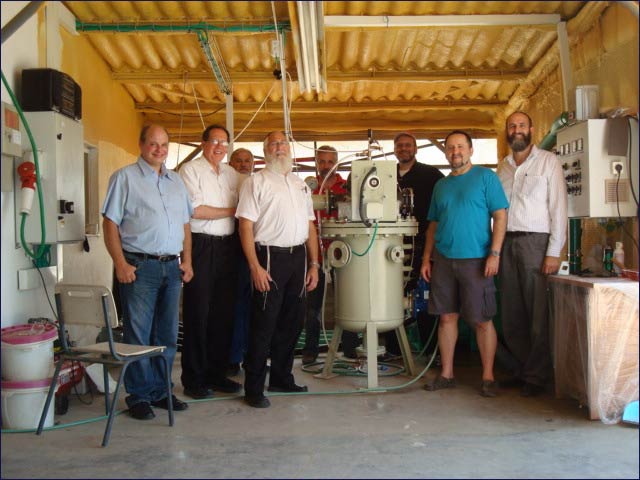By Avigayil Kadesh
Water rushing through underground pipes often creates a lot of excess pressure. Instead of building dams or installing pressure breaks, why not funnel that pressure into hydroelectric power?
That’s the novel idea behind a groundbreaking clean-tech turbine from Leviathan Energy Hydroelectric, the newest venture from the same award-winning Israeli team that introduced the Wind Tulip for harnessing electricity from wind.
“What you see here is a breakthrough that opens up a new energy market - hydroelectric power within piping systems,” says CEO Dr. Daniel Farb. “New technology can come from anywhere, and Israel is a leader in water technology because it is in a desert climate.”
The Jerusalem-based Leviathan recently launched a testing site at Kibbutz Re’im in the Negev Desert, where many parts for the new hydroelectric turbine are manufactured on site by Isralaser. Shlomo Wald, chief scientist of the Ministry of Energy and Water, was on hand for the unveiling.
Farb, an immigrant from Los Angeles, named the turbine “Benkatina” in tribute to Ben Katin, a Second Temple high priest who engineered a machine to lower and raise the ancient Temple’s ceremonial hand-washing basin to and from the water table. The engineer for the modern version based on Farb’s vision was Avner Farkash, Leviathan’s vice president for research and development.
“The Benkatina turbine is different from the way hydroelectric power was done for 200 years,” Farb explains. “In the past, they used a dam, used up all the pressure, worked in an environment of stable flow, and used turbines that could be exposed to the air. In-pipe conditions are different, so there is no dam, which makes it more ecologically viable. Only the excess pressure is used so the integrity of the piping system can be maintained, the flow is variable, and it functions in a difficult, closed-system environment with splashing water.”
The company received a grant from the Chief Scientist of the Israeli Ministry of Trade and Labor under the Eureka program to develop the technology, as well as a grant from the Ness Fund for business development in the Negev.

From left at the Benkatina test facility at Kibbutz Re’im are
Leviathan Energy’s Zeev Savion, Daniel Farb, Morris Gal, Kalman Kolman, Boris Grad, Joe van Zwaren,
Moshe Rosenfel and Avner Farkash.
Installed in Israel and Philippines
The eco-friendly and durable system is still being tweaked for maximum efficiency, but it has already gotten what Farb terms “beta sales” from Israel’s national water carrier Mekorot, and from the Philippines. An Italian partner is lined up next, and Farb recently met with a power company in Mumbai.
“We’re getting requests from all over the world,” he says. “There are several thousands of potential locations even in Israel, which could provide power for the grid fairly quickly – by next summer (2013) -- to help ease the electricity crisis here. With the proper resources, we could soon add several more megawatts of power on the grid.”
And in remote areas in need of moderate amounts of power, a smaller version of the Benkatina turbine could provide off-grid electricity using nearby water pipes, and it would be more consistently reliable than either solar or wind energy, says Farb.
The beauty of the system is that it works with the existing infrastructure.
“Managers of water systems already know where there is excess pressure, and often they put pressure breakers in those locations to prevent leaks from forming. One of the great things about what we’re doing is that we are battling the water and energy shortage at the same time,” Farb points out. “An estimated $14 billion worth of water is wasted each year through leakage, and decreased pressure means decreased leaks.”
The turbine wouldn’t be installed in parts of the piping without extra pressure. “We don’t want you to turn on the tap and have nothing come out,” Farb says.
Benkatina could potentially be fashioned from, or coated with, different kinds of materials for different in-pipe conditions. “We’re looking forward to the challenge of operating in caustic environments, such as various types of dirty water, but right now we’re dealing with plain water,” says Farb. “The ability to control output pressure is the next thing we’re working on.”
Enabler for Dead Sea canal?
He adds that this technology could be a key enabler for the proposed Dead Sea canal. “I can foresee desalinated water coming from the Gulf of Eilat or from the Mediterranean to the Dead Sea through pipes, and taking off some of the extra pressure in many points along the way to use for hydroelectricity,” he says.
“Instead of building dams that take up space and flood communities, the water can be diverted at many points where elevation is below zero. This turbine would be perfectly suited to help distribute the water to communities or farms that may develop along the way.”
Farb, whose expertise is in flow physics, explains that Leviathan’s hydroelectric focus complements its work in wind power.
“The theme of a lot of my innovations, and those of members of our team, is that we’re in an energy crisis that will last at least 100 years and we have to provide solutions in more than just one area. We need wind, wave, water, solar and everything put together. I feel the world is headed for major trouble, and I’ve provided a series of solutions that, when fully implemented with the right financial and bureaucratic support, can make a serious difference in the world we live in.”